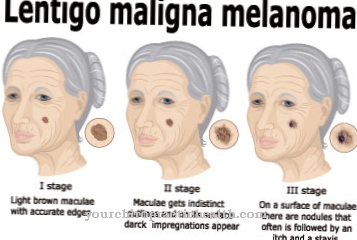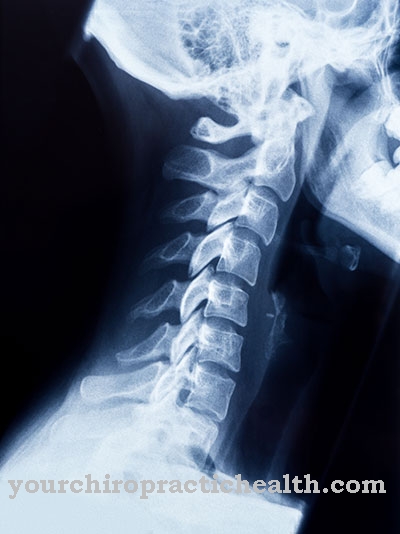A Mastocytosis is a rarely occurring disease in which there is a pathological accumulation of so-called mast cells (defense cells). These can accumulate in the skin or in the internal organs. The mastocytosis is usually harmless; in some cases, however, it can also be aggressive or malicious.
What is mastocytosis?

© mitay20 - stock.adobe.com
Under the term Mastocytosis Doctors understand a very rare disease. This leads to an increased and ultimately pathological accumulation of mast cells.
These are involved in the immune defense and release messenger substances such as histamine, for example. If the mast cells accumulate too much, they cause a kind of allergic reaction to certain triggers. A basic distinction is made between two types of mastocytosis: cutaneous mastocytosis only affects the skin, while systemic mastocytosis affects internal organs or tissues.
Mastocytosis can be symptom-free or, in more severe cases, severely limit the daily life of those affected. Outbreaks often occur as a result of certain triggers, such as food or other illnesses. The exact causes of mastocytosis are not yet known.
causes
Why there is one in some people Mastocytosis has not yet been clearly clarified. In many adult patients, however, scientific research has found a genetic change that could be related to the development of mastocytosis.
This is a mutation of the growth receptor KIT, which is located on the mast cells. This mutation leads to uncontrolled growth of the cells and ultimately to mastocytosis.
No such change was found in children with mastocytosis. It is a mutation that has no influence on the actual germ cell and is therefore only passed on through heredity in the rarest of cases.
Symptoms, ailments & signs
Mastocytosis can cause a wide variety of complaints and symptoms. Some patients experience few symptoms, while other patients experience serious discomfort. Exactly which symptoms occur depends on where in the body they occur and how much the mast cells are multiplied. The symptoms of mastocytosis can range from tiredness and skin irritation to stomach pain, nausea and vomiting.
Typically, the symptoms appear on the surface of the skin. Then brown-red spots form on the torso, thighs and buttocks. The spots can reach a diameter of three millimeters to a few centimeters, with mostly small spots in adults and large spots in children. If the spots are touched, an unpleasant itching occurs in the affected area.
In the course of the disease, wheals develop, which multiply and cause a reddish rash. The skin changes occur in all forms of mastocytosis and often resolve on their own. Complaints such as weight loss, shortness of breath, fever and hot flashes, which occur in the advanced stages of the disease and must be treated, are different.
In severe cases, it can lead to a circulatory collapse. The symptoms usually occur in stressful situations, for example under stress or after consuming alcohol or large meals.
Diagnosis & course
A Mastocytosis can (in the cutaneous form of the disease) be diagnosed in some cases on the basis of typical red-brown skin changes. However, an exact diagnosis often causes problems for the attending physician, as the disease does not always manifest itself through typical symptoms. A tissue sample of the skin and possibly also of the bone marrow can provide information about the presence of mastocytosis. A high level of tryptase on a comprehensive blood test suggests mastocytosis. This is a protein that is present in the mast cells and whose level increases when there is an increased occurrence of it.
The course of mastocytosis depends largely on the individual characteristics of the individual case. A significant reduction in quality of life can only rarely be expected.
Complications
Due to mastocytosis, those affected primarily suffer from skin problems. This leads to relatively strong redness and pigmentation disorders, whereby pigment spots can also occur. It is not uncommon for mastocytosis to lead to reduced self-esteem or to inferiority complexes, as those affected feel uncomfortable or are ashamed of their appearance.
Swellings or blisters also appear on the affected areas of the skin and papules continue to form. Patients also experience vomiting or nausea. Furthermore, there are discomforts in the stomach or diarrhea and a stomach ulcer can develop. In the further course there is a sharp drop in blood pressure, which can also lead to a loss of consciousness.
The quality of life is significantly reduced and restricted by the complaints and symptoms of mastocytosis. As a rule, the symptoms can be limited and fought well with the help of medication. There are no complications. However, the underlying disease must also be treated and treated itself so that the symptoms do not occur in the twitch. As a rule, it cannot be universally predicted whether this will result in a reduced life expectancy.
When should you go to the doctor?
If symptoms such as a diffuse feeling of illness or decreased wellbeing occur, it is advisable to consult a doctor to clarify the symptoms. A doctor is needed in the event of stomach pain, digestive tract complaints, nausea or vomiting. If there is increased fatigue, rapid exhaustion or fatigue, a doctor should be visited. The present irregularities indicate a health impairment and should be cleared up in medical tests. Changes in the appearance of the skin, the formation of wheals or swellings are warning signs of the organism. They should be examined and treated. Discuss stains on the skin or discoloration with a doctor.
If the existing symptoms gradually increase or if they continue to spread, a doctor's visit is necessary. Persistent itching, hot flashes, or increased body temperature should also be presented to a doctor. If the person is experiencing shortness of breath or breathing interruptions, there is cause for concern. Sleep disorders, internal weakness and a decrease in normal performance are further signs of an existing disorder in the organism. If there are irregularities in the heart rhythm, anxiety due to breathing disorders or a decrease in concentration, a doctor should be consulted. In the event of a breakdown in the cycle, an emergency service must be alerted and first aid measures initiated.
Treatment & Therapy
Treating a Mastocytosis usually includes alleviating individual symptoms and, if the respective triggers are known, avoiding them. The therapy can include, for example, the administration of certain medications, such as antihistamines, such as those used in allergies, or preparations containing cortisone. Particularly occurring itching and similar symptoms can be alleviated in this way. Painkillers can then be taken when needed.
If the exact triggers for the allergy-like symptoms are known, they should be avoided in any case. This can include, for example, alcohol, spicy food, certain foods or even insecticides. However, mastocytosis patients should always carry an emergency kit with them that includes medication to be administered in the event of a severe reaction to a trigger. Even if mastocytosis is often harmless and almost unnoticed or can be treated well with targeted therapy, the disease cannot be cured.
Outlook & forecast
The chances of recovery depend on the point at which mastocytosis occurred.Basically, forms of disease can be distinguished in children and adults. A good prognosis can be formulated for children. The symptoms usually disappear after the second and third year of life. Then those affected can continue a life free of signs. Only in rare cases does a chronic form develop. This means that the characteristic complaints are then permanent.
In adults, mastocytosis first occurs during puberty. The prognosis is much worse here. Because in the majority of diseases, the typical skin spots and other complaints remain for a lifetime. You can even gain weight easily. An improvement, including a cure, only occurs in around one in ten patients. Sometimes adult patients can relieve symptoms by avoiding certain triggers.
Many of those affected find the burden of mastocytosis to be low. Since the disease is only rarely malignant, there is usually no shortened life expectancy. Even without treatment, the symptoms disappear in the greater number of children. Adults, on the other hand, have to live with the signs of mastocytosis.
prevention
Since the exact causes for a Mastocytosis are not yet known, prevention in the strict sense is not possible. However, if a disease already exists or symptoms appear that suggest it, regular doctor visits should take place in order to monitor the patient's state of health. A healthy lifestyle and avoidance of individual triggers can help contain the disease and significantly alleviate symptoms.
Aftercare
Because mastocytosis is incurable and treatment is complex and lengthy, follow-up care focuses on managing the disease well. Sufferers should try to focus on a positive healing process despite the adversity. To build the appropriate posture, relaxation exercises and meditation can help calm and focus the mind.
In addition, if you unexpectedly feel unwell, this should be discussed immediately with the attending physician in order to prevent the symptoms from worsening. The earlier a doctor is contacted, the better the further course of this disease will usually be. As a rule, mastocytosis leads to extreme tiredness and fatigue in the person concerned.
The strains of the illness can in the long term favor the development of depression or other psychological upsets. It is important to observe this and, if necessary, to clarify with a psychologist. Therapy can help to better accept the situation and improve the quality of life.
You can do that yourself
So far there is no effective therapy against mastocytosis. It is therefore important for those affected to live with as few symptoms as possible. This is achieved with the help of symptom-oriented therapy and by avoiding individual triggers.
Food and active ingredients that promote the products of mastell cytokines and thus cause the symptoms should therefore be avoided. A low-histamine diet includes avoiding certain foods and drinks. Which foods are tolerated varies from person to person and is best recorded with the help of a nutrition plan. In addition, some guiding principles apply. For example, foods that are stored for longer generally contain more histamines. Cooking, freezing, baking or frying will destroy the fabric. Self-prepared meals are also tolerable. Alcohol, on the other hand, should be avoided because beer, wine and the like inhibit the histamine-degrading enzyme.
Furthermore, an emergency kit should always be on hand, because an anaphylactoid reaction can occur even without a recognizable trigger. Such an emergency kit contains, depending on the trigger and the severity of the disease, antihistamines, glucocorticoid and an adrenaline auto-injector. Which agents should be carried in detail must always be clarified with the responsible doctor.




.jpg)






















